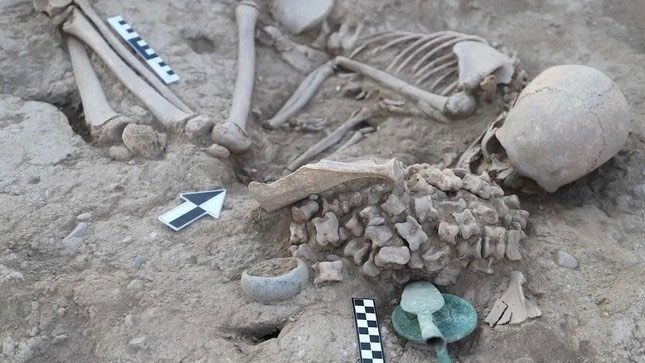Archaeologists in Kazakhstan have unearthed the grave of a Bronze Age girl and many buried objects , including many animal bones believed to have been used by the deceased in the afterlife. .
Since 2017, researchers have been working at the excavation site, located in Ainabulak, a village in the east of Kazakhstan. Since then, they have discovered more than 100 graves dating back to the Bronze Age, including the one with the girl they found on August 2, according to Kazakhstan’s The Astana Times.
Although researchers know little about the girl’s identity, the wealth of artifacts in her tomb reveal clues about her status within the Bronze Age community in the Central Asian country spanning from 3200 BC and 1000 BC, according to Oxford Academic.
 The tomb contained the remains of a teenage girl and many animal skeletons. (Photo: Ministry of Science and Kazakh University).
The tomb contained the remains of a teenage girl and many animal skeletons. (Photo: Ministry of Science and Kazakh University).
“The girl was buried in the south,” said Rinat Zhumatayev, an archaeologist and head of the Department of Archaeology, Ethnology and Museology at Al-Farabi Kazakh National University in Kazakhstan, who led the excavation. left. There were earrings in both ears and beads around her neck.”
Radiocarbon dating of the skeleton showed that the girl was about 12 to 15 years old when she died . Archaeologists also discovered that she was buried with 180 astragalus (ankle) bones – possibly from sheep or cattle – along with several metal sword hilts, a mirror and a bowl copper.
The custom of burying astragalus bones
However, an object that stands out more to archaeologists is the bronze plate carved with a frog in the middle. This discovery marks the first time such an object has been discovered in Kazakhstan.
“The image of the frog has had different meanings for many peoples since ancient times,” Zhumatayev said . It is associated with the image of working women and worshiping water… but more research is needed to determine its true meaning.”
Researchers were also fascinated by the large number of animal bones buried in the tomb. Although they had seen tombs containing animal remains on the Eurasian steppe, often burying children and adolescents, the fact that hundreds of remains were buried with this individual was extravagant. .
Some scientists believe that the burial of astragalus bones was part of a “cult custom” and that the bones were used during meditation. However, other researchers believe that bones are a symbol of happiness and luck and the desire for a successful transition from one world to another.
In addition to this burial site, archaeologists also made a groundbreaking discovery of a pyramid with a hexagonal base in the Abai region, north of the site. All these findings have important historical and cultural significance for the study of the early Bronze Age, Zhumatayev said.





